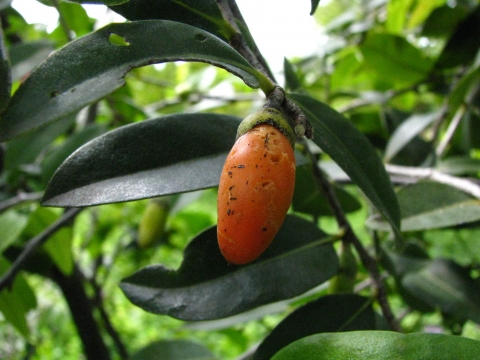Diospyros sandwicensis
(A.DC.) Fosberg
Ebenaceae
Common Name:

Fruit and leaves
Photograph by: David Eickhoff
Creative Commons Attribution 2.0

Fruit and leaves
Photograph by: David Eickhoff
Creative Commons Attribution 2.0

Growing in the forest understory in Hawaii
Photograph by: Forest and Kim Starr
Creative Commons Attribution 3.0


The reddish-brown colour of the young leaves
Photograph by: Forest and Kim Starr
Creative Commons Attribution 3.0


Cross-sections of male and female flowers
Photograph by: David Eickhoff
Creative Commons Attribution 2.0
General Information
Diospyros sandwicensis is a small, slow-growing tree, usually growing 7 - 13 metres tall[
399- Title
- Hawaiian Native Plant Propagation Database
- Publication
-
- Author
-
- Website
- http://pdcs.ctahr.hawaii.edu:591/hawnprop/
- Publisher
-
- Year
- 0
- ISBN
-
- Description
- Detailed information on the propagation of a wide range of Hawaiian plants.
].
The plant is utilised locally from the wild as a source of timber and medicines.
Known Hazards
None known
Botanical References
Range
Pacific - Hawaii.
Habitat
It occurs, sometimes as a dominant plant, in dry to moist forests and occasionally in wet forests, growing at elevations ranging from almost sea level to 1,200 metres[
399- Title
- Hawaiian Native Plant Propagation Database
- Publication
-
- Author
-
- Website
- http://pdcs.ctahr.hawaii.edu:591/hawnprop/
- Publisher
-
- Year
- 0
- ISBN
-
- Description
- Detailed information on the propagation of a wide range of Hawaiian plants.
].
Properties
| Edibility Rating |      |
| Medicinal Rating |      |
| Other Uses Rating |      |
| Habit | Tree |
| Height | 10.00 m |
| Cultivation Status | Wild |
Cultivation Details
We have seen no individual confirmation for this species, but in general Diospyros species are dioecious and require both male and female forms to be grown if fruit and seed are required[
899- Title
- Tree Flora of Sabah and Sarawak Vols 1 - 6
- Publication
-
- Author
- Soepadmo E.; Saw L.G.; Chung R.C.K. (Editors)
- Publisher
- Forest Research Institute Malaysia; Kuala Lumpur.
- Year
- 2002
- ISBN
- 983-2181-27-5
- Description
- A flora of the woody plants of Sabah and Sarawak on the island of Borneo, often giving details of plant uses.
].
Edible Uses
Fruit[
]. The fruit is about 18cm in diameter[
399- Title
- Hawaiian Native Plant Propagation Database
- Publication
-
- Author
-
- Website
- http://pdcs.ctahr.hawaii.edu:591/hawnprop/
- Publisher
-
- Year
- 0
- ISBN
-
- Description
- Detailed information on the propagation of a wide range of Hawaiian plants.
].
Medicinal
The plant is often used medicinally in Hawaii, but usually as a secondary ingredient in combination with other herbs. It is used mainly in external applications to treat problems such as burns, cuts, boils, abscesses, bruises, and cold sores[
].
Other Uses
The reddish-brown wood is very hard and close-grained[
46- Title
- Dictionary of Economic Plants.
- Publication
-
- Author
- Uphof. J. C. Th.
- Publisher
- Weinheim
- Year
- 1959
- ISBN
- -
- Description
- An excellent and very comprehensive guide but it only gives very short descriptions of the uses without any details of how to utilize the plants. Not for the casual reader.
]. It is traditionally used for making statues of gods, for house posts, and house fences[
].
Propagation
Seed - it has a very short viability and so should be sown as soon as possible[
]. The flesh should be removed since this contains germination inhibitors[
]. Sow the seed in a shady position in a nursery seedbed. The sowing media for ebony uses soil and fine sand at the ratio 3:1. The seed is planted horizontally or vertically with
the radicle end down, with a sowing depth of 1 - 1½ times the thickness of seed. Distance between the seeds is 3 - 5cm. Seeds are very sensitive to desiccation during germination and early growth, so must be regularly watered at this time[
]. Normally the seed will germinate after one week. In one trial, fresh seed, sown one day after collection, showed 85% germination rate within 17 - 65 days[
].
As a rule fresh seeds have a high percentage of fertility. The seedlings develop long taproots at an early stage, often before any appreciable elongation of the shoot takes place. The growth of the seedling is decidedly slow [
652- Title
- The Silviculture of Indian Trees
- Publication
-
- Author
- Troup. R.S.
- Website
- http://www.biodiversitylibrary.org
- Publisher
- Oxford, at the Clarendon Press
- Year
- 1921
- ISBN
-
- Description
- An excellent treatment.
].
If you have any useful information about this plant, please leave a comment. Comments have to be approved before they are shown here.







 Useful Tropical Plants Database 2014 by
Ken Fern,
web interface by
Ajna Fern
with help from
Richard Morris.
Useful Tropical Plants Database 2014 by
Ken Fern,
web interface by
Ajna Fern
with help from
Richard Morris.